
|
|
|
The DASH WEAPON SYSTEM
In the mid 1950's the Russian Submarine force was becoming increasingly ominous in size (numbering over 300) and capabilities and the U.S. Navy sought a method to counter that threat before any submarine could come within striking distance of a U.S. Naval ship or convoy. The Navy was developing a rocket-launched anti-submarine torpedo called ASROC (Anti-Submarine ROCket), but it was too limited in range to take advantage of increased detection ranges of that day that the large AN/SQS-26 Sonar system promised. ASROC was also very expensive and complex requiring each ship to be reconfigured by installing a complex control system. Adding to these issues were Naval Aviators who were not receptive to the idea of launching manned helicopters from small destroyer decks at high sea states. The Navy needed a solution to conduct their Anti-Submarine Warfare missions and there were no solutions in sight. By 1956, The Gyrodyne Company, a small
company located in
Five of Gyrodyne's one-manned "Rotorcycles" ( 2- XRON-1's and 3-YRON-1's-seen right) had been built for the U.S. Marine Corp for a flight demonstration study in 1954, when the U.S. Navy asked Gyrodyne if such a vehicle could be used to provide a cheap method of delivering conventional and nuclear anti-submarine weapons at a range from surface ships several orders of magnitude greater than other current systems capabilities. Accordingly, in April 1958, the Navy
awarded Gyrodyne a contract to make minimum modifications to its model RON-1
Rotorcycle in order to investigate the feasibility of its use
The QH-50A was to be the evaluation prototype for the airborne portion of the system and be capable of carrying one Mark 43 homing torpedo. On August 12, 1960, a QH-50A drone made the world's first free flight of an unmanned helicopter at the Naval Air Testing Facility at Patuxent River, Maryland (seen left). It was powered by one Gyrodyne-Porsche engine. On that date, the Drone Anti-Submarine Helicopter (DASH) concept was realized.
DASH: From Concept to Reality By the
time DASH was ready to make its fleet operational appearance in November of
1962, the QH-50A design had changed dramatically and
Eventually, the QH-50A design was changed
to incorporate a heavy fuel turbine engine (T50-BO-8) made by Boeing Aircraft
that would increase reliability. The design was then also changed to allow for
twin torpedo carrying
How DASH Operated from Destroyers
The takeoff and landing controller had a station at deck level
on one side of the ship at the hangar. He was able to control the collective
pitch by setting the altitude wheel on the left on the deck control. The heading was controlled
by
the large knob left of the indicator display.
On takeoffs in sea states ranging from calm to No. 6, the controller applied full power and set a higher altitude, which applied up collective pitch on the rotors. Then he released the hold-down cable and the aircraft climbed. At the predetermined altitude set on the control station, the aircraft leveled off and was guided on the pre-selected heading towards its target by the deck controller.
When CIC takes over the DASH
In the meantime, another controller in the Combat Information Center (CIC) has
observed the helicopter on the radar scope indicator at his station. He set his
dials to conform with the flight speed, heading and altitude of the flying QH-50C. On signal, control was passed from the deck officer to CIC. The CIC controller operated from a dual-purpose scope that followed the drone by the MK-25 fire control radar system and indicated the target submarine location as determined by SQS-23 sonar detection system. He was able to track the drone using the SPS-10 tracking radar. Using these three integrated sources of information, the CIC controller was able to maneuver the drone towards the target. When the sonar and radar-indicated drone positions coincided, and the target had been identified as an enemy submarine, the CIC controller actuated the arming and release switches, dropping the MK-44 homing torpedoes or the Mark 17 nuclear depth charge with W 44 warhead. After weapons release, the drone was flown back to the vicinity of the ship. At this point, the deck controller took
over and landed the aircraft on the flight deck by Upon landing, the engine was shutdown with the rotors stopped and secured. At rotor rpms of 400 or less, special gust locks activate to prevent the blades from contacting each other in heavy seas. After the gyroscopes were allowed to spin down, the aircraft was connected to assist wires in a sea state of 2 and above, and the aircraft was winched back into the hangar and tied down. In calm seas, simple ground handling wheels made moving the drone easy. After tie down, the log book entry was made and the drone was readied for its next mission. The Navy's DASH Management The AIRBORNE PORTION of DASH
By July 1963, the Navy had assumed this role at two Fleet Introduction Sites (FIS); One FIS at San Clemente Island off the California Coast and another at Dam Neck, Virginia. Responsible for running these training schools were Utility Squadron Three (VU-3) on the West Coast and Utility Squadron Six (VU-6) on the East Coast. Overall program control for the Navy was by the Anti-Submarine Warfare Division headed by Rear Adm. J. N. Shaffer who reported to the Deputy Chief of Naval Operations. Program management was located in the Bureau of Naval Weapons under Rear Adm. Allen M. Shinn, with the Program Officer being Cdr. J.C. Henderson in the directorate for under sea warfare programs. Pictured left, left to right, is Rear Adm. William H. Groverman, Director of Anti-Submarine Research; Gyrodyne's President, Peter J. Papadakos and right is Rear Adm. J.N. Shaffer visiting Gyrodyne's QH-50C DASH manufacturing facility on May 23, 1962.
The SHIP PORTION of DASHOriginally DASH was a stand-off ASW weapons program designed to operate from U.S. Naval destroyers, but by 1960, the Sumner, Gearing and Fletcher class destroyers as well as destroyer tenders of various classes, were aging and in need of major overhaul and reconstruction to accommodate the new weapons systems. After careful analysis of the situation, the Secretary of the Navy ordered the beginning of the Fleet Rehabilitation and Modernization (FRAM) program. This amounted to a complete refurbishment of the ships' hulls and machinery and the addition of new superstructures. The FRAM program consisted of two levels of
modernization; the more extensive FRAM I reconstruction and the somewhat less
extensive FRAM II modernization. The FRAM I program involved installation of
both the ASROC and DASH systems. The FRAM II program was developed primarily for
the Sumners, which had insufficient hull length amidships to accommodate
the ASROC system. In the FRAM I reconstructions, one of the twin 5-inch gun
mounts was removed as weight compensation for the ASROC system, but the FRAM II
modernization kept all three of their 5-inch gun mounts (unless the destroyer
was equipped with a Variable Depth Sonar (VDS) in which a mount was lost for
weight compensation). The following U.S. Naval Shipyards were engaged in the FRAM program:
| |||||||||||||||||||||||||||||||||||||||||||||||||||||||||||||||||||||||||||||||||||||||||||||||||||||||||||||||||||
| Type of Facility | Geographic Location | Gyrodyne Group |
| U.S. Naval Base | Yokosuka, Japan | Gyrodyne Mobile Technical Support Group/NAESU covered Western Pacific and South Pacific, assigned to MOTU-7 / COMCRUDESPACLOGREP |
| U.S. Naval Air Station | Cubi Point, Philippines | Gyrodyne Mobile Support Group assigned to MOTU-13 |
| U.S. Naval Base | Honolulu, Hawaii | Gyrodyne Mobile Technical Support Group (covering Mid-Pacific operations) |
| Sixth Fleet H.Q. | Naples, Italy | Gyrodyne Mobile Technical Support Group (covering Mediterranean Sea and European Waters) |
| Headquarters- Atlantic Destroyer Base | Newport, Rhode Island | Gyrodyne Support Group |
| Naval Air Station (NAS)-NATC | Patuxent River, Maryland | Gyrodyne Air Development Group |
| NAS Utility Squadron Six (VTU-6) | Norfolk, Virginia | Gyrodyne Eastern Fleet Introduction Support (FIS) Group |
| Naval Weapons Services Office for Ships Trials and Qualifications | Norfolk, Virginia | Gyrodyne Technical Assistance Group |
| Naval Base-Destroyer Operating Flotilla | Norfolk, Virginia | Gyrodyne Operational Support Group |
| Naval Base-Destroyer Operating Flotilla | Charleston, South Carolina | Gyrodyne Operational Support Group |
| NAS- Overhaul And Repair Operation | Jacksonville, Florida | Gyrodyne Training Group |
| Naval Base-Destroyer Operating Flotilla | Mayport, Florida | Gyrodyne Operational Support Group |
| Eglin Air Force Base- Climatical Operational Testing | Panama City, Florida | Gyrodyne Technical Support Group |
| Naval Base- Operational Test and Evaluation | Key West, Florida | Gyrodyne Technical Support Group |
| Naval Base | Bremerton, Washington | Gyrodyne Mobile Services- detached from San Diego |
| Naval Base | San Francisco, California | Gyrodyne Mobile Services- detached from San Diego |
| Naval Base | Long Beach, California | Gyrodyne Mobile Services- detached from San Diego |
| Naval Ordnance Test Station Utility Squadron Three (VTU-3) |
San Clemente Island, California | Gyrodyne Western Fleet Introduction Support (FIS) Group |
| Naval Air Station Utility Squadron Three (VTU-3) |
North Island, California | NAESU Headquarters & Gyrodyne Material Support Group |
| Headquarters- Pacific Destroyer Base | San Diego, California | Gyrodyne Support Group and Mobile Support Group |
| Naval Weapons Services Office for Ships Trials and Qualifications | San Diego, California | Gyrodyne Technical Assistance Group |
While it would be impossible to identify the responsibilities that each Gyrodyne Group was responsible for within this space, an example of what services Techreps performed, operating from Gyrodyne Mobile Technical Support Group in Yokosuka, Japan, for the Seventh Fleet, can be seen in the following example when the inevitable Casualty Report (CASREPS) would be received, indicating trouble:
For the Western Pacific Fleet (WESTPAC), the DASH/NAESU (Naval Air Technical Engineering Data and Services Command) employees were attached to MOTU-7 (Mobile Ordnance Training Unit). Comprised of both military and civilian technical personnel, the unit was required to provide technical assistance to ships that required help with their installed systems. This was not easy. Operating from Yokosuka, Japan, Gyrodyne personnel would find themselves responding to a CASREP by getting aboard a military aircraft, flying to Cubi Point in the Philippines, catching a COD (Carrier Onboard Delivery) plane out to a carrier conducting operations off Vietnam, waiting until the destroyer with a problem was within range of the carrier's helicopter, and then being lowered down in a horse collar to the deck of the destroyer. After recovering from the inevitable seasickness, fixing the problem, and being officially detached, the GCA employee would make their way back to Yokosuka anyway they could.
Eventually, the GCA/NAESU employees
convinced COMCRUDESPAC (Commander,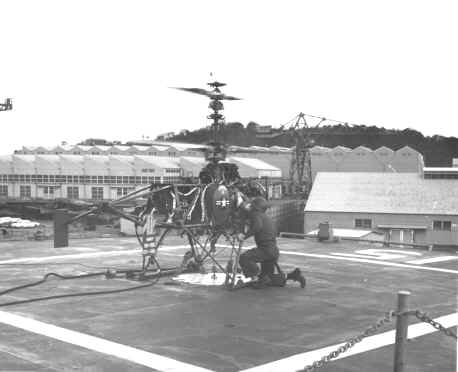 Cruiser/Destroyers Pacific) that to improve the system performance, it was better to
fix a discovered problem then wait for every destroyer in the flotilla to
discover the problem itself. As a result, all DASH/NAESU representatives at
Yokosuka were transferred to the CRUDESPAC Logistics Representative office
(CRUDESPACLOGREP). This allowed for better communications as the Logistics
Representative had direct communication with all destroyers and tenders to
provide training as well as technical assistance. As seen at right, a
crewman runs up QH-50C (s/n DS-1024) on the Destroyer Tender, Prairie (AD-15),
at Yokosuka, Japan-1963.
Cruiser/Destroyers Pacific) that to improve the system performance, it was better to
fix a discovered problem then wait for every destroyer in the flotilla to
discover the problem itself. As a result, all DASH/NAESU representatives at
Yokosuka were transferred to the CRUDESPAC Logistics Representative office
(CRUDESPACLOGREP). This allowed for better communications as the Logistics
Representative had direct communication with all destroyers and tenders to
provide training as well as technical assistance. As seen at right, a
crewman runs up QH-50C (s/n DS-1024) on the Destroyer Tender, Prairie (AD-15),
at Yokosuka, Japan-1963.
With the increased tempo of operations in the area, corrosion became a major problem. The Logistics Representative initiated a corrosion control program with the aircraft repair facility at the Atsugi Naval Air Station (using Japanese aircraft repair facilities). This allowed the GCA representatives to identify problem drones and arrange for their removal and replacement with a corrosion free aircraft.
The Gyrodyne Helicopter Historical Foundation thanks Captain Robert H. Beyer USNR (ret) for his contribution to the DASH Weapon System history. Captain Beyer was a Techrep for Gyrodyne based in Japan from 1963 to 1970. When DASH was cancelled in 1970, he remained with Gyrodyne and returned to the United States.
What Happened to DASH?
DASH operations ceased fleet wide on
November 30, 1970 after the U.S. government had invested over $275 million
dollars on the aircraft side of that Anti-Submarine Warfare (ASW) program. Although then Secretary of
Defense McNamara stated, in his budget report to Congress of January 1967, that
"Last year, the DASH ASW drone helicopter was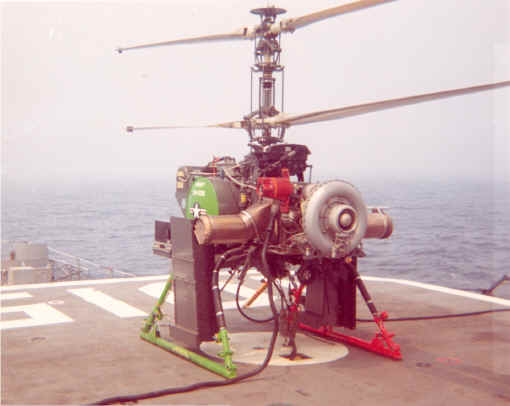 encountering
higher-than-expected peacetime attrition and lower-than-expected performance..."
the real reason was simple: The continued war in Vietnam was draining production
funds from all sectors of the military. To make matters worse for DASH, the
Vietnam war was not an "anti-submarine warfare" (ASW) war.
encountering
higher-than-expected peacetime attrition and lower-than-expected performance..."
the real reason was simple: The continued war in Vietnam was draining production
funds from all sectors of the military. To make matters worse for DASH, the
Vietnam war was not an "anti-submarine warfare" (ASW) war.
As DASH was
originally designed to drop Mk 57 nuclear depth charges or torpedoes, it was built with
the idea that it would not survive the resulting blast. Accordingly, DASH was
built with a non-redundant avionics control system using
"off-the-shelf" components whenever possible to minimize costs.
Further, the lack of a "feed-back-loop" from the drone to the controller prevented the operating drone controller from knowing the drone's orientation. This was exacerbated by the low radar profile of the QH-50 to the ships tracking radar and the lack of transponders resulted in the loss of many drones due to not knowing WHERE the drones were in relation to the ship. This was confirmed with the installation of the SNOOPY TV surveillance system when a TV interface indicated that the drone was responding to commands, but the controller did not know its whereabouts.
The initial DASH electronic control system also contributed to problems. The complexity of the GFE system and the multitude of components and fail-proned wiring harnesses and cannon plugs coupled to a simple FM radio control system made maintenance a major chore for ship board personnel. The complexity of the airborne system can be illustrated by the following:
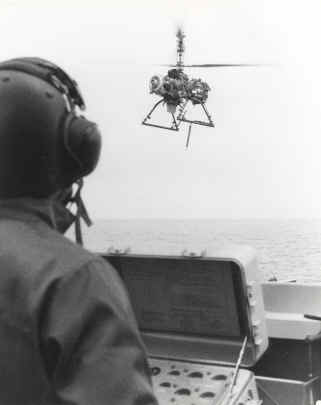 When the Deck Control Officer (seen
left) used the Deck Control Transmitter to launch a Drone, he
maneuvered the Drone using stick control of cyclic roll, pitch and flat turns
and knob control for altitude and heading. Digital signals were then sent from
the Control Transmitter to a relay assembly for assignment to an audio frequency
coder. Digital audio command signals were then transmitted by UHF line-of-sight
data link. The drone's transistorized FM radio receiver eliminated the carrier
frequency and applied the audio frequency to the drone's decoder. The decoder
extracted the digital messages, decoded the command information and provided
analog voltages (as well as on-off switch closures for torpedo arming and
release mechanisms). The analog voltages were combined with sensor inputs from
roll, pitch and displacement gyros and altitude control, and then fed to an
Electronic Control Amplifier (ECA). The ECA in turn controlled the pitch, roll,
yaw and collective servo clutches in the drones electro-mechanical
actuator.
When the Deck Control Officer (seen
left) used the Deck Control Transmitter to launch a Drone, he
maneuvered the Drone using stick control of cyclic roll, pitch and flat turns
and knob control for altitude and heading. Digital signals were then sent from
the Control Transmitter to a relay assembly for assignment to an audio frequency
coder. Digital audio command signals were then transmitted by UHF line-of-sight
data link. The drone's transistorized FM radio receiver eliminated the carrier
frequency and applied the audio frequency to the drone's decoder. The decoder
extracted the digital messages, decoded the command information and provided
analog voltages (as well as on-off switch closures for torpedo arming and
release mechanisms). The analog voltages were combined with sensor inputs from
roll, pitch and displacement gyros and altitude control, and then fed to an
Electronic Control Amplifier (ECA). The ECA in turn controlled the pitch, roll,
yaw and collective servo clutches in the drones electro-mechanical
actuator.
All these systems, both ship based and airborne based were NON-REDUNDANT and IF one single command system component failed, the Drone would be lost. This can seen in the following:
80% of all losses of QH-50 vehicles were due to either ship based or airborne electronic system failures | |
10% were due to Controller-Pilot-Error | |
5% were due to enemy action over Vietnam | |
5% were due to airframe/engine failure. |
With the ASW DASH program nearing cancellation, the Advanced Research Projects Agency (ARPA)- the research arm of the Department of Defense- saw an opportunity to use the existing QH-50C/D's still on destroyers in a effective manner.
The QH-50C/D DASH Goes to War
While then Secretary of Defense McNamara was downplaying the reliability of the QH-50 to congress in January 1967, he left out the fact that he had authorized the Navy to expand the QH-50's mission outside of it's DASH-ASW role to that of flying surveillance missions into Vietnam.
Beginning in January 1965 and acting upon
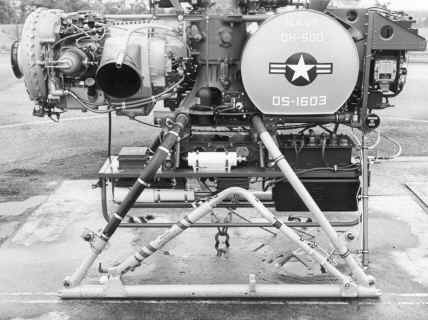 the inventiveness of the Executive Officer, Phil King, aboard the destroyer, USS
BLUE (DD-744), the Navy started flying reconnaissance "SNOOPY" missions from selected destroyers. This involved the
modification to the QH-50 system by the installation of real-time video and film
cameras for reconnaissance and surveillance (seen left).
Also installed was a telemetry system so remote pilots could monitor their
actions upon the aircraft and a transponder for radar tracking of the Drone.
These modifications allowed for real-time intelligence gathering for gun
spotting of critical targets (such as bridges and re-supply-by-ship barges) for
waiting off-shore warships. The typical range of a DASH-launching destroyer's
5" guns was nine nautical miles whose projectiles had a fragmentation burst
[kill zone] of about 75 yards.
the inventiveness of the Executive Officer, Phil King, aboard the destroyer, USS
BLUE (DD-744), the Navy started flying reconnaissance "SNOOPY" missions from selected destroyers. This involved the
modification to the QH-50 system by the installation of real-time video and film
cameras for reconnaissance and surveillance (seen left).
Also installed was a telemetry system so remote pilots could monitor their
actions upon the aircraft and a transponder for radar tracking of the Drone.
These modifications allowed for real-time intelligence gathering for gun
spotting of critical targets (such as bridges and re-supply-by-ship barges) for
waiting off-shore warships. The typical range of a DASH-launching destroyer's
5" guns was nine nautical miles whose projectiles had a fragmentation burst
[kill zone] of about 75 yards.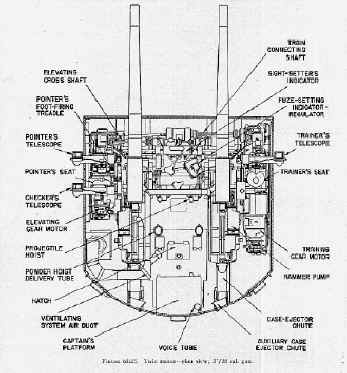 With a firing rate of 4 to 6 rounds every few
minutes, SNOOPY loitering time averaged 1 hour resulting in a saturation level
of the target area to a point where resistance was eliminated. According
to a Gunner's Mate (GM1) on the USS George K. Mac Kenzie (DD-836) they set a
record when they fired 151 rounds in five minutes from their 5"/38 caliber
guns but then had to cool the barrels off with the fire hose. This was in
preparation for a Marine landing on a small peninsula not far from Da Nang. The
Marine spotter in his small Piper aircraft called the landing off. He said there
was not a tree left standing and nothing left to hide the enemy!
With a firing rate of 4 to 6 rounds every few
minutes, SNOOPY loitering time averaged 1 hour resulting in a saturation level
of the target area to a point where resistance was eliminated. According
to a Gunner's Mate (GM1) on the USS George K. Mac Kenzie (DD-836) they set a
record when they fired 151 rounds in five minutes from their 5"/38 caliber
guns but then had to cool the barrels off with the fire hose. This was in
preparation for a Marine landing on a small peninsula not far from Da Nang. The
Marine spotter in his small Piper aircraft called the landing off. He said there
was not a tree left standing and nothing left to hide the enemy!
Each round had a 55 lb projectile loaded, set with a proximity fuse to detonate just before the shell hit the ground (Point Detonation, High Capacity). Each projectile was filled with shrapnel as well as HE (high explosive).
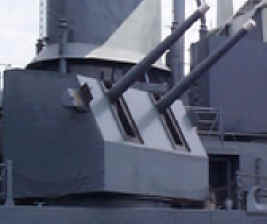 Further, the barrel of the 5"/38 caliber gun did wear out with this type of
use. Using basic rounds, the tube life expectancy was about 1,500 rounds but as
muzzle velocity increased, a drop of about 800 rounds was to be expected in tube
life. Replacing these gun barrel on the FRAM destroyer was not an easy thing:
The method involved a special wrench which attached at the base of the barrel,
and a 20 LB sledge hammer. The barrel - unscrewed.
Disassembled from the turret, the barrel weighed some 18 Tons. This was the
process for the foreword mounts. For the Aft 5" mount at the fantail (Mount
53), it was completely taken off the ship and taken to the overhaul shop.
A month later it was brought back and it was like brand new.
Further, the barrel of the 5"/38 caliber gun did wear out with this type of
use. Using basic rounds, the tube life expectancy was about 1,500 rounds but as
muzzle velocity increased, a drop of about 800 rounds was to be expected in tube
life. Replacing these gun barrel on the FRAM destroyer was not an easy thing:
The method involved a special wrench which attached at the base of the barrel,
and a 20 LB sledge hammer. The barrel - unscrewed.
Disassembled from the turret, the barrel weighed some 18 Tons. This was the
process for the foreword mounts. For the Aft 5" mount at the fantail (Mount
53), it was completely taken off the ship and taken to the overhaul shop.
A month later it was brought back and it was like brand new.
The QH-50C/D flew in a hostile environment where no
manned aircraft dare to fly in.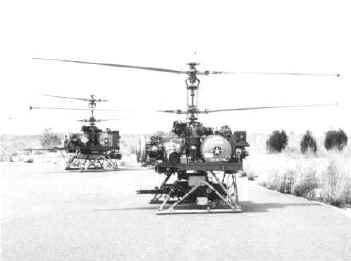 Success using SNOOPY was measured in American
lives saved by using the unmanned QH-50 helicopter. Losses of QH-50's in Vietnam
are not accurately known, but by June 1, 1970, the Navy did state that of the
original 746 QH-50C/D drone helicopters originally built for DASH, 411 aircraft
had been lost.
Success using SNOOPY was measured in American
lives saved by using the unmanned QH-50 helicopter. Losses of QH-50's in Vietnam
are not accurately known, but by June 1, 1970, the Navy did state that of the
original 746 QH-50C/D drone helicopters originally built for DASH, 411 aircraft
had been lost.
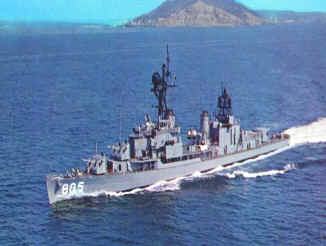 By late 1969, DASH began to be removed from FRAM destroyers as they returned to
their home ports for overhaul work. On the destroyer, USS CHEVALIER (DD-805),
for example, the DASH hangar was converted into a "nifty looking"
crews lounge with fake wood paneling and a suspended ceiling covering the
overhead florescent lights. The only problem with this installation was that it
was installed with pop-rivets. The first time CHEVALIER fired its after 5 inch
guns, the entire hangar lounge was destroyed when the ceiling crashed down and
most of the paneling fell off! The DASH hangar was later used to simply store
all the stuff the crew bought overseas.
By late 1969, DASH began to be removed from FRAM destroyers as they returned to
their home ports for overhaul work. On the destroyer, USS CHEVALIER (DD-805),
for example, the DASH hangar was converted into a "nifty looking"
crews lounge with fake wood paneling and a suspended ceiling covering the
overhead florescent lights. The only problem with this installation was that it
was installed with pop-rivets. The first time CHEVALIER fired its after 5 inch
guns, the entire hangar lounge was destroyed when the ceiling crashed down and
most of the paneling fell off! The DASH hangar was later used to simply store
all the stuff the crew bought overseas.
THE QH-50: After DASH, SNOOPY and Vietnam
Although Project "SNOOPY" reconnaissance flights over Vietnam ceased by 1970,
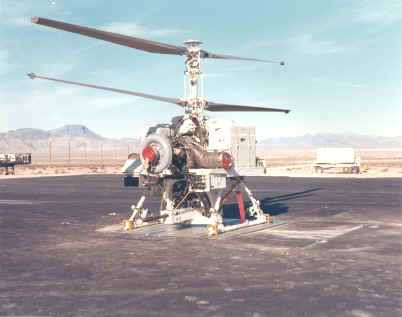 continued testing by ARPA in conjunction with the U.S. Army allowed for other
follow up programs using the unique coaxial, unmanned QH-50D helicopter such as
the night-reconnaissance "Nite Panther" (seen below) and the
covert target acquisition "Blow-Low". Around this time, the other
remaining QH-50 aircraft were transferred to Naval Air Station China Lake and
the U.S. Army at White Sands Missile Range for use as target drones. There the
aircraft were used to test and improve the next generation of anti-aircraft
missiles and air defense systems. The Army used the QH-50 extensively in Stinger
(Avenger) and FAADS (Sgt. York) T & E. During the
"Base-realignment" of 1996, NAS China Lake transferred all remaining
Navy QH-50 aircraft to the on-going U.S. Army White Sands Missile Range QH-50
operations.
continued testing by ARPA in conjunction with the U.S. Army allowed for other
follow up programs using the unique coaxial, unmanned QH-50D helicopter such as
the night-reconnaissance "Nite Panther" (seen below) and the
covert target acquisition "Blow-Low". Around this time, the other
remaining QH-50 aircraft were transferred to Naval Air Station China Lake and
the U.S. Army at White Sands Missile Range for use as target drones. There the
aircraft were used to test and improve the next generation of anti-aircraft
missiles and air defense systems. The Army used the QH-50 extensively in Stinger
(Avenger) and FAADS (Sgt. York) T & E. During the
"Base-realignment" of 1996, NAS China Lake transferred all remaining
Navy QH-50 aircraft to the on-going U.S. Army White Sands Missile Range QH-50
operations.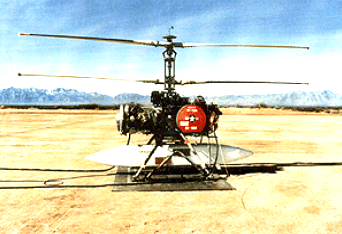
Today, the QH-50C/D continues to fly everyday on "no-kill-missions". This means that the aircraft is not intentionally shot down. Instead the aircraft acts as a target radar/IR emulator testing missile guidance and ground based attack equipment capabilities so that future American fighting forces receive the best equipment in the field possible. A QH-50D at White Sands, operated by U.S. Army's Program Executive Office, Simulation, Training and Instrumentation (PEO STRI) (Simulation, Training and Instrumentation Command) is seen left. The QH-50: After 42 years and still going strong!
THE QH-50 Overseas: The Japanese DASH
While
the U.S. Navy's DASH program was in full operation, the Navy loaned the
Japanese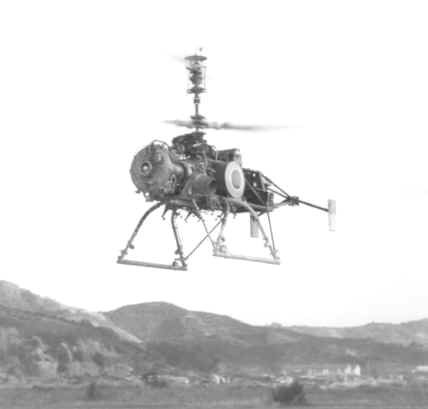 Maritime Self-Defense Force (JMSDF) three QH-50C drones under the Military
Assistance Program (MAP) and sold the JMSDF a
single D model aircraft in 1965 to see if DASH
could bolster the JMSDF's ASW capabilities. The C model serial numbers were DS-1278, DS-1279 and DS-1280.
The D model was DS-1494.
Maritime Self-Defense Force (JMSDF) three QH-50C drones under the Military
Assistance Program (MAP) and sold the JMSDF a
single D model aircraft in 1965 to see if DASH
could bolster the JMSDF's ASW capabilities. The C model serial numbers were DS-1278, DS-1279 and DS-1280.
The D model was DS-1494.
With a dual torpedo delivery capability in any weather, a 45 mile
delivery range and the close proximity to Soviet Union (USSR) Naval Bases, the
Japanese were very interested in the DASH concept. After testing, the JMSDF
purchased 16 additional aircraft from Gyrodyne in 1967 (All D models) through
the Nissho-Iwai Trading company, with the final delivery
in September 1971. They were serial numbers J-1 through J-16.
Right,
QH-50C, number
DS-1279, flies for the first time on November 15, 1966 from the training base at
Eta Jima, Japan; the JMSDF training facility. By early 1970,
SEVEN Japanese
Destroyers were flying DASH with a success rate of 500 hours MTBL. These
destroyers consisted of four "Moon" or "Zuki" class and
three "Cloud" or "Gumo" class ships. The construction
sequence of the first six of seven were:
|
First: TAKATSUKI |
Second: KIKUZUKI |
Third: MOCHIZUKI |
|
Fourth: NAGATSUKI |
Fifth: MINEGUMO |
Sixth: NATSUGUMO |
|
|
Seventh: MURAKUMO |
Due to the fact the JMSDF was a "defense" force, their deployments on ship were short, thus decreasing costs associated with expensive support equipment. Perhaps due to this economic decision, several QH-50's were achieving a phenomenal success such as:
|
Japanese Maritime Self-Defense Force (JMSDF) DASH Performance Highlights |
||
| Aircraft Type | Serial Number | Number of Landings |
| QH-50C | DS-1279 | 1140 |
| QH-50D | J-3 | 2660 |
| QH-50D | J-7 | 2270 |
| QH-50D | J-12 | 1308 |
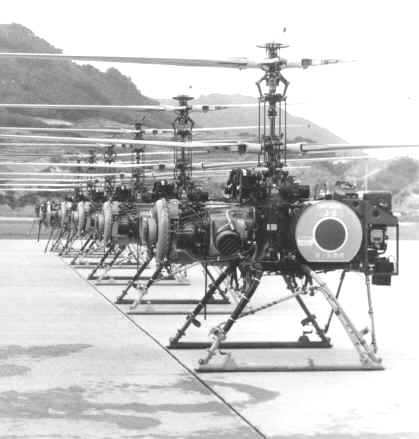
Although a success in the JMSDF, concerns over Gyrodyne's continued viability in the face of the U.S. Navy's DASH program cancellation, caused the JMSDF DASH program to cease in 1977. At that time, the Japanese had lost only three reported aircraft. What happened to the remaining QH-50s is not known.
As seen left, 4 QH-50D and 2
QH-50C aircraft are shown in a line up at the Japanese training site at Eta Jima
island which was also the site for the JMSDF Naval Academy; June 1970.
THE Company that
Built DASH

Today
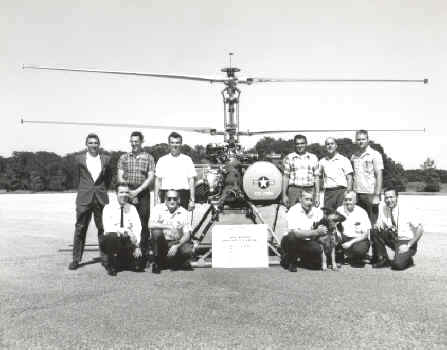 Surprisingly, the Gyrodyne Helicopter Company continued to operate beyond
the date that the last QH-50 (a D model, s/n DS-1758) helicopter rolled off the
production line on August 29, 1969 (photo of Pete
Ackles -with dog, and his final assembly crew, seen left with the last QH-50D
built).
Surprisingly, the Gyrodyne Helicopter Company continued to operate beyond
the date that the last QH-50 (a D model, s/n DS-1758) helicopter rolled off the
production line on August 29, 1969 (photo of Pete
Ackles -with dog, and his final assembly crew, seen left with the last QH-50D
built).
For the next 30 years Gyrodyne
serviced the Navy and Army with parts to keep their aircraft flying. Then, in
1999, the helicopter company moved from its home of 50 years in Long Island, New
York to Los Angeles, California in an attempt to restart the firm.
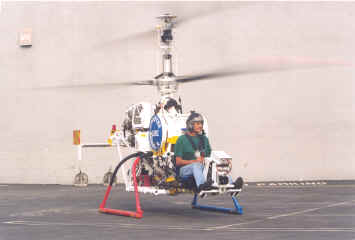
From October 1999 to March 2004, the Gyrodyne-Ca Company (its test article- a E model seen at right) continued to sell parts and provide technical service to the existing users of the QH-50C/D and assist a German-based licensee that was considering manufacturing a modified QH-50 for NATO use. Gyrodyne also continued to improve upon on their existing QH-50's in the hope that the Department of Defense would again find a better tactical use for their unmanned helicopter that served in both the Cold and Vietnam wars without a single American life lost, but it was not meant to be. With the war on terrorism in Afghanistan and the second Iraq war, the Department of Defense did not support the only vendor of the only deployed VTOL-UAV system in the world and Gyrodyne was forced to close. Many key assets were donated to the Gyrodyne Foundation for preservation and/or museum placement.
E Mail him at: Gyrodyne_History@Yahoo.com
![]()
![]()
|
The name "Gyrodyne" in its stylized
form above, is the Trademark of and owned by the Gyrodyne Helicopter Historical
Foundation; unauthorized use is PROHIBITED by Federal Law. All Photographs, technical specifications, and
content are herein copyrighted and owned exclusively by Gyrodyne Helicopter
Historical Foundation, unless otherwise stated. All Rights Reserved
©2013. |